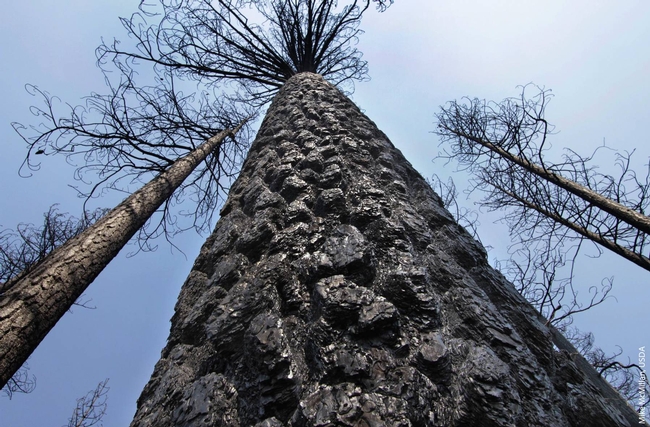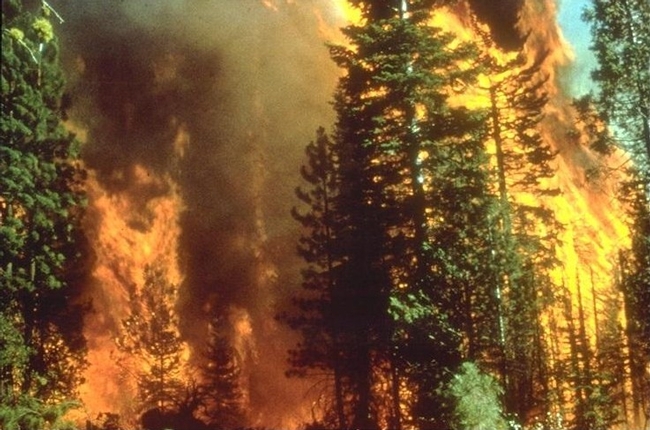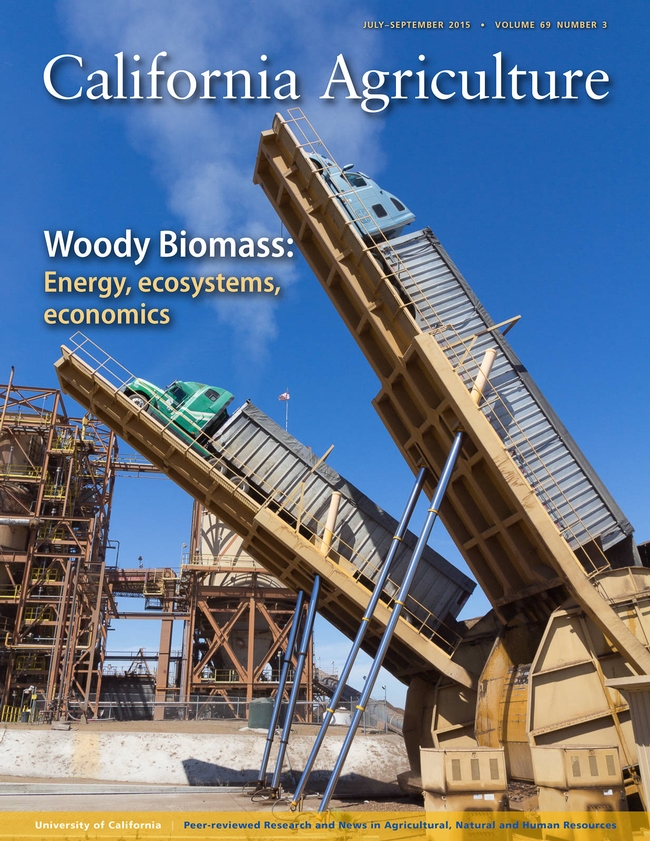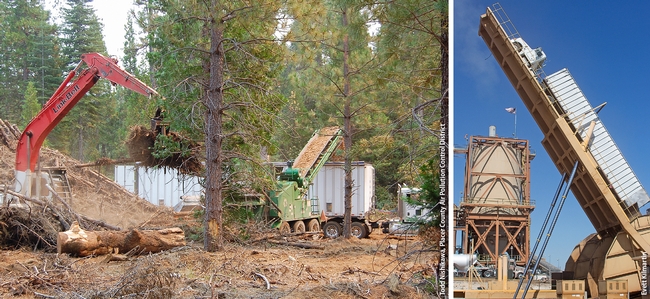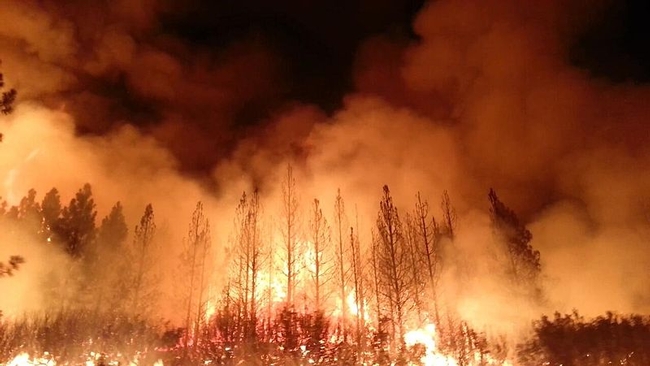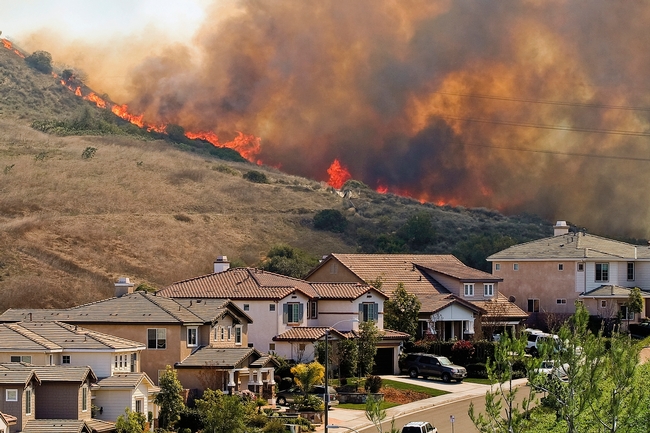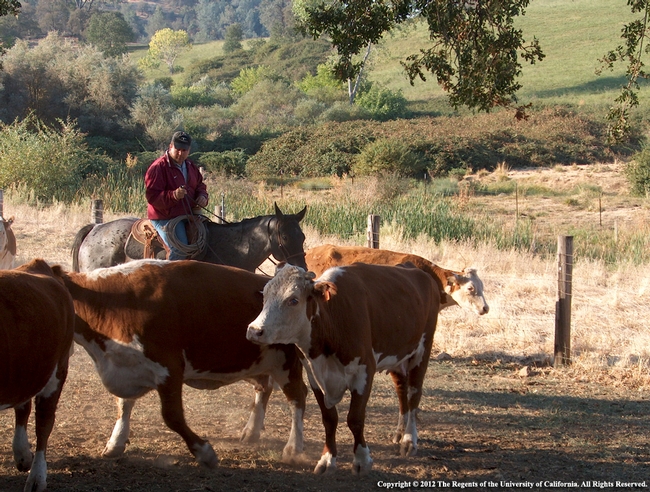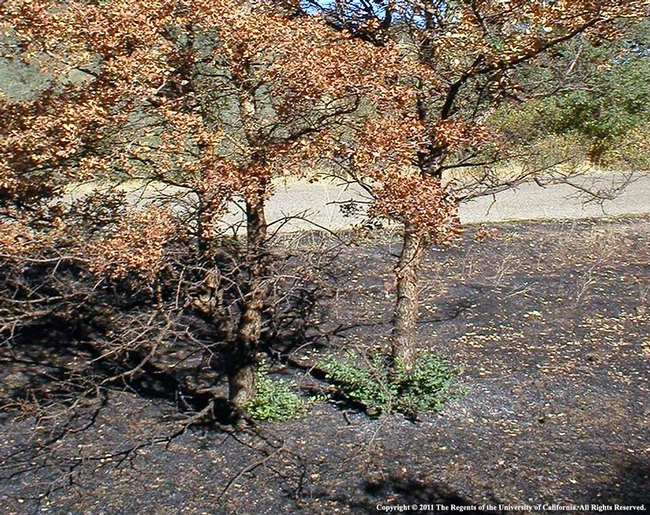Posts Tagged: wildfire
Burned forestland needs erosion protection
“The loosened soil and ash can move quickly under proper storm conditions,” said Greg Giusti, a UC ANR Cooperative Extension forestry advisor. “Property owners should take immediate action.”
A longstanding practice in the West has been spreading grass seed after a fire, however, the seed is slow to germinate and grow during the cold months that follow fire season.
“Seeding is generally ineffective,” Giusti said. “The seed simply moves and erodes with the soil and ash following an initial rain event.”
After losing a home, homeowners may feel the need to clean up their property. However, leaving woody debris, downed trees and limbs will arrest soil movement. Stumps and standing dead trees also help protect the soil.
“The roots are still in the soil and will help hold it in place,” Giusti said. “As long as they don't pose a danger, trees should be left in place.”
Spreading rice straw or weed-free hay on the ground is another way to protect the soil from erosion. Whole bales of hay can be placed in natural drainages to slow water movement and reduce erosion. Straw wattles – long tubes of compressed straw encased in jute or another material – may be laid out across a slope and secured with stakes.
“I suggest landowners focus on areas of their property where they can have the greatest positive effect,” Giusti said. “You can't cover a whole hillside with straw. People can only do what they can do.”
An initiative to maintain and enhance sustainable natural ecosystems is part of UC Agriculture and Natural Resources Strategic Vision 2025.
California wildfires are linked to climate change
In an article printed last week in the Los Angeles Times, fire scientists cast doubt on Gov. Jerry Brown's assertion that the intense wildfire season of 2015 was connected to global climate change. A UC Agriculture and Natural Resources (UC ANR) expert, however, responded with a letter to the editor that said publishing such information is "troubling."
"It's splitting hairs, as scientists often will, to note that we may not know conclusively whether climate change has caused this particular drought and these specific wildfires," wrote Max Moritz, a UC ANR Cooperative Extension specialist in the Department of Environmental Science, Policy and Management at UC Berkeley. "As a wildfire scientist, I find it troubling that this nuance became front-page news because it implies more uncertainty about climate change that there really is among experts."
Other writers' comments about the misleading article were also published. Alex Hall of the UCLA Center for Climate Change Solutions said "an analysis of the probability that the current fire season in California would play out as it has, if climate change were not in the picture has not been done." Jonathan Parfrey of Climate Resolve said "The Times really blew it in this piece."
In the conclusion of his letter, Moritz wrote: "In fact, there is relatively strong agreement among fire scientists about links between climate change and wildfire, even if quantitative attribution poses challenges. To raise awareness about climate change and to reduce its long-term impacts, we need our leaders to speak out."
What to do with woody waste in forests?
The destructive Rough, Valley and Butte fires have raised awareness of the abundant wildfire fuels in forests, leading to calls for thinning to reduce fire risk. But where should land managers put the small trees, limbs and treetops they remove? How does thinning affect forest structure, wildlife and pests? The latest edition of UC Agriculture and Natural Resources' California Agriculture journal contains a collection of peer-reviewed research articles on forest biomass energy, ecosystems and economics.
One way of disposing of the woody material is to burn it in biomass power plants to generate energy. However, nearly half of the power plants in California that run on woody biomass are operating on contracts that are set to expire in 2016, and low-cost solar power may deter utilities from renewing those contracts.
In his Outlook article, “The wood in the forest: Why California needs to reexamine the role of biomass in climate policy,” Peter Tittmann, academic coordinator for the Woody Biomass Utilization Group at UC Berkeley, writes, “By incentivizing better forest management and improved forest health, biomass energy leverages considerable climate and other environmental benefits beyond the direct reductions in carbon emissions from generating electricity from a renewable resource.”
UC scientists are evaluating the feasibility of using small, portable biomass power generators that could be moved to a forest thinning site, reducing the cost of transporting the biomass to a plant. Electricity generated in remote locations could be sold for a premium. Read more in “Following the fuel: How portable biomass energy generation may help rural communities.”
Peer-reviewed articles:
Forest biomass diversion in the Sierra Nevada: Energy, economics and emissions
In a Sierra Nevada case study, converting forest waste to electricity yielded energy and emission benefits, but was not economically viable. The authors suggest financial incentives for reduced air pollution could compensate.
Effects of fuel treatments on California mixed-conifer forests
Contrary to what some environmentalist advocates have argued, prescribed fire, mastication and thinning to modify wildfire behavior may have positive effects on the ecology of yellow pine and mixed-conifer forests.
Thinning treatments had minimal effect on soil compaction in mixed-conifer plantations
In mixed-conifer plantations in the Sierra Nevada, no large impacts were seen from commercial thinning or chipping treatments.
Modeling fuel treatment impacts on fire suppression cost savings: A review
Fuel treatments appear to reduce future fire suppression costs, but the savings are unlikely to fully offset the cost of the treatments.
To read all of the articles in the current California Agriculture, visit http://californiaagriculture.ucanr.edu.
California Agriculture is a peer-reviewed journal of research in agricultural, human and natural resources published by UC ANR. For a free subscription, visit californiaagriculture.ucanr.edu, or write to calag@ucanr.edu.
Southern California is at risk for a giant fire, too
Responding to the giant fire that burned 39 homes and 70,000 acres in the Clear Lake area, Warren Olney of KCRW's Which Way LA asked a UC Agriculture and Natural Resources (UC ANR) fire expert in Southern California, "Could it happen here?"
"It happens here all the time," said Tom Scott, wildlife and urban interface UC ANR Cooperative Extension specialist in the Department of Environmental Science, Policy and Management at UC Berkeley. (Scott is based at UC Riverside.)
He said of the 50 major fires recorded on the CalFire website, 30 were in Southern California. "It will probably happen again."
Media outlets are reporting that the Rocky Fire in Northern California is burning so hot, it is creating its own weather. Scott said the phenomenon is less likely to occur in Southern California fires.
"A lot of times our fires are coupled with Santa Ana winds," he said. "You don't necessarily see the fire creating its own wind because winds are already blowing 50 or 60 miles per hour."
One thing that can lead to particularly hot fires in the LA area is the lack of summer rain.
"This creates a very dry environment in the summertime," Scott said. "Plants can dry down to a point where they ... are very low moisture, which makes them very flammable. The other thing is, our plants don't decompose. We have a lot of biomass hanging around for a long time, sometimes centuries. When that burns, there's a tremendous amount of fuel and it causes hot and quick-moving fires."
Clearing a defensible zone around homes in fire-prone areas is one way to reduce the risk that a house will burn down. But it takes a long-term concerted effort to manage the landscape to prevent fires from becoming major conflagrations that roar from the mountains to the sea, Scott said.
"One of the things that a lot of people imagine," he said, "is where we can get back to a point where the landscape has fires that are smaller, at a time (of year) when it's not as hot and we don't have Santa Ana winds."
In the meantime, people in fire-prone areas may consider putting their irreplaceable valuables in storage from April to November, he said.
Wildfires are unpredictable, but preparation can help protect homes and animals
Four years of drought has left California with acres of dry brush and dying trees, abundant fuel for wildfires. Currently, CalFIRE's fire map shows several major fires burning in California.
“There are two factors that help fires spread - winds and topography,” explained Scott L. Stephens, a professor of fire science in the Department of Environmental Science, Policy and Management at UC Berkeley, in Scientific American. “The thing about wind is, it can change so quickly and the fire will change with it — it can happen in 15 seconds,” said Stephens, who is also co-director of the Center for Fire Research and Outreach at UC Berkeley.
Wildfires are unpredictable, but there is much that residents of fire-prone areas can do to keep their families, homes and pets safe. UC Agriculture and Natural Resources has many online resources for homeowners and landowners in English and in Spanish for dealing with fire.
Protecting homes from fire
To protect houses in the wildland-urban interface from fire, homeowners should start with fire-resistant building materials and architectural features. The Center for Fire Research and Outreach at UC Berkeley has a toolkit for homeowners to assess their vulnerability to fire and offers advice for mitigating fire risk.
On the Sustainable and Fire Safe Landscapes website, Sabrina Drill, UC ANR Cooperative Extension natural resources advisor for Los Angeles and Ventura counties, gives tips for creating defensible space around the house. She also provides suggestions for designing a landscape around the home that reduce risk of fire spreading from plants to the structure.
Protecting animals from fire
The School of Veterinary Medicine at UC Davis offers resources for preparing a plan for horses, livestock and pets in case of wildfire or other disaster. A disaster preparedness plan would include things like transportation for evacuating the animals and emergency shelter.
What to do after a fire
If your home is burned, the Center for Fire Research and Outreach has a list of resources and things to do after a fire, including contacting a local relief organization to help with housing, food and other essentials. Before re-entering the home or site, the center recommends checking with the fire department to ensure it is safe to do so.
In oak woodlands, wildfires are an ecologically important process. Fire may actually help sprouting oaks survive by eliminating competing plants and creating a more favorable seedbed for acorns to germinate, and reducing the habitat of wildlife species that eat acorns or seedlings, according to Doug McCreary, UC ANR Cooperative Extension advisor emeritus.
Wildfire in an oak woodland can kill some trees outright and leave others with burn damage that may or may not eventually kill them. UC Cooperative Extension has developed a quick method for assessing the extent of burn damage and the likelihood that an affected tree will survive. Instructions can be downloaded for free at http://anrcatalog.ucdavis.edu/Items/8445.aspx
For forest landowners, UC ANR has “Recovering from Wildfire,” a guide that covers how to protect land from erosion damage, where to get help and financial assistance, how to manage salvage harvesting, and how to help the forest recover from wildfire.
Preparing communities
UC ANR fire experts work with the California Fire Science Consortium to integrate science into sound fire prevention programs.
In the Lake Tahoe region, UC ANR Cooperative Extension advisor Susie Kocher collaborates with University of Nevada Cooperative Extension and Tahoe Basin fire agencies on a community education project called Living with Fire. Together they provide information for Lake Tahoe communities to prepare for wildfire. Many of the recommendations could apply to any community.


